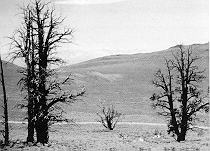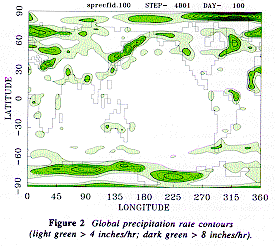About two miles high, in the White Mountains of eastern California, grows a unique tree, Pinus aristata (also referred to as Pinus longaeva).1 Commonly known as the Bristlecone pine, it is not a tall or stately appearing tree; it is very slow growing, only one inch in diameter per 100 years and up to 25-30 feet tall.2 The remarkable fact about the tree is that it is noted as the oldest known living thing in the world, far surpassing the vastly more famous Sequoia.2 Due to the remote location of Bristlecone forests, few people have heard of these trees, much less visited the area of their growth.
The Bristlecone pine became famous in scientific circles through the work of Dr. Edmund Schulman (1908-1958) of the University of Arizona. His dendrochronological studies spanned almost thirty years, of which the last five were spent mostly in the White Mountains.1 Through the study of annual growth rings of these trees, a fairly precise method of absolute dating has been obtained. So far, this amazing record from the Bristlecone pines only applies to the southwestern portion of the United States and has become useful also to the field of archaeology where ancient roof beams have been more accurately dated using the tree-ring growth records. 3

The White Mountains rise abruptly east of the Sierra Nevadas, reaching over 14,000 feet in elevation near the ancient Bristlecone pine forest. They lie in the rain shadow of the Sierras, with an average annual rainfall of 10-13 inches.1 The Bristlecones live between the elevations of 9,500 and 11,500 feet, sculptured into stubby, twisted shapes by the harsh environment.4 Needles stay on the trees for up to thirty years, and seeds of the oldest trees are just as viable as the youngest.1
A Bristlecone pine tree may comprise up to 90% dead wood--a thin vein of living tissue is often surrounded and protected by the dead wood.2 The soil in the ancient forest is very alkaline, comprised of dolomitic limestone, which supports the growth of only one other type of tree--the Limber pine.2 Few other plants survive in these conditions, and the Bristlecone pine forest appears quite desolate compared to the environment of most other forests.
Bristlecones grow in other similar areas and were already the focus of much speculation when Schulman arrived on the scene in 1953. A reported 4900-year-old tree in the Snake Ridge region of Nevada was actually discovered to be only 3000 years old.1 Schulman quickly found a tree in the White
Mountains dating back about 4300 years and named it Pine Alpha, the first found anywhere with an absolute date older than 4000 years.2 During his last season of research—the summer of 1957—he discovered "Methuselah," a tree dating back 4600 years.5 No older tree has been discovered since then, and the Methuselah tree is not marked so as to protect it from souvenir hunters.4
Schulman's work was carried on and extended after his death by Drs. H. C. Fritts and Charles W. Ferguson, also of the Laboratory of Tree Ring Research at the University of Arizona.1 To tap into trees without damaging them, a special Swedish incremental borer was used. Borings up to forty inches long and as thin as pencil lead are removed from the living trees.1 Ferguson then started sampling the dead wood found scattered on the southern slopes of the mountains and found that the loose dead wood did not match the existing ring patterns. The gap between living and dead wood was first breached by A. E. Douglas while testing prehistoric beams in ruins near Show Low, Arizona.1 Ferguson was able to make a continuous tree-ring record that eventually reached 8680 years before the present in the mid-1970s.4 Dating research in the 1980s did reach a growth-ring series of about 11,300 rings, but has led to much debate over the possibility of multiple ring growth during many periods of climatic history.6,7 This would allow for a more recent dating than the individual growth rings show. Similar dates have been obtained in parallel research done on European oak and pine trees.7 The dates that were obtained so far have been used to correct errant radiocarbon dating readings which had significant errors in dates over 3000 years before present.1,7 These tree-ring dates offer much in the way of significance for creation research, particularly the dating of Noah's flood and ultimately creation.
Irish Archbishop James Ussher (1581-1656) did serious work in Genesis chapters 5 and 11 to compile genealogical chronologies that were widely accepted in his day.8 Scientists such as Isaac Newton believed in Ussher's work, which was even published for years in the margins of the King James Version of the Bible, starting in 1701.9 Ussher placed the date of Noah's flood at 2350 B.C. and creation at 4004 B.C.10 Other Biblical scholars have researched dates for the flood ranging from 3398 B.C. to 2348 B.C.11 and creation between 3760 B.C. and 5555 B.C.8 Of course, "modern" evolutionists have held these dates up for ridicule, but the Bristlecone pine research may well verify them.

Flood and Creation Dating the oldest Bristlecone pines now living quite possibly have been growing since right after the flood. With "Methuselah" going back to around 2600 B.C. according to Dr. Ferguson, this becomes a very real possibility. The actual date may be adjusted for extremely wet years which occurred in the past, as shown by the numerous dry lakes in the desert regions of eastern California and Nevada. Experiments show the trees can grow more than one ring in unusual seasons.6 Some experiments have even suggested that many periods of time could have been characterized by the growth of one extra ring every one to four years, with evidence in controlled laboratory situations showing extra ring growth tied to short drought periods.12 These varied conditions could allow a slightly more recent date which may even closely match Ussher's date of 2350 B.C.
Even without adjustment, the living Bristlecones do fit well within the range of dates for the flood provided by numerous Biblical scholars. However, some recent debate concerning the record of rings found in the dead wood has led to proposals of much older dates for the flood, and ultimately creation. Flood dates in the range of 10,000 to 15,000 years before present have been suggested,6 but it could be possible that the preserved dead wood grew in the period before the flood. Only the living trees by strict necessity need date from the time of the flood or more recent times. In that case, the pre-flood trees would have to remain in the same vicinity probably anchored as stumps, for the period of around a year until the flood waters receded. The ring-growth record from the pre-flood period would also have to be as extensive as it is in the current trees in the forest. If the dead wood was still viable for sprigs and seeds, this would explain the continued existence of the Bristlecone pine forest in the same location.
Dead wood, both on the trees and on the ground, have provided a tree-ring record going back to proposed dates of around 6800 B.C. or earlier.6,7This causes a little bit more problem for the Ussher dating, but it is not insurmountable. The same argument for multiple ring growth in wet years could hold, and even the possible pre-flood greenhouse environment that may have existed on earth may have been a factor. Also, creation had to involve some superficial appearance of earth history. Trees were likely created with tree-rings already in place. Rocks would likely have yielded old dates by the faulty radio-isotope methods in use today. Even man and animals did not appear as infants. This is known as the "Appearance of Age Theory."13 Even with only minor adjustments in the growth-ring-to-year correlation, most creation scientists would feel quite comfortable with a resulting date of creation in the 6000-7000 B.C. range.
Did God preserve the Bristlecone pines, with their unique combination of living and dead wood, as a record of recent creation? We don't know for sure, but dendrochronology is certainly a science that provides facts which evolutionists do not care to publicize.
- Johnson, Russ and Anne, "The Ancient Bristlecone Pine Forest." Chalfant Press, Bishop, CA., 1970.
- Anonymous, "Ancient Bristlecone Pine Forest." Government Printing Office, Washington D.C., 1981.
- Deetz, James, "Invitation to Archaeology." The Natural History Press, Garden City, N.Y., 1967, pp. 37-40.
- Miller, Brian, "Methuselah Walk." Eastern Sierra Interpretive Association, Bishop, CA., no date.
- Miller, Brian, "Bristlecone Discovery Trail." Eastern Sierra Interpretive Association, Bishop, CA., 1977.
- Aardsma, Dr. Gerald E., "Tree-Rings Dating and Multiple Growth Ring Per Year." Creation Research Society Quarterly, volume 29, March 1993, pp. 184-189.
- Beasley, Greg J., "Long-Lived Trees: Their Possible Testimony to a Global Flood and Recent Creation." Creation Ex Nihilo Technical Journal, vol. 7 (1), 1993, pp. 43-67.
- Morris, Dr. Henry M., The Genesis Record. Baker Book House, Grand Rapids, MI., 1976, pp. 42-45, 280-285, 308-310, 675.
- Sippert, Albert, From Eternity to Eternity. Sippert Publishing Company, North Mankato, MN., 1989, pp. 46,47,188-190.
- Morris Dr. Henry M. The Biblical Basis for Modern Science. Baker Book House Grand Rapids MI., 1984, pp. 449-454.
- Brown, Walter T., Jr., In the Beginning. Center for Scientific Creation, Phoenix, AZ., pp. 108,109.
- Lammerts, Walter E., "Are the Bristlecone Pine Trees Really So Old?" Creation Research Society Quarterly, volume 20, September 1983, pp. 108-115.
- Whitcomb, John C., The Early Earth. Baker Book House, Grand Rapids, MI., 1972, pp. 40-48.
* Mr. Lorey, M.A., has published many articles in history and geology.
Cite this article: Lorey, F. 1994. Tree Rings and Biblical Chronology. Acts & Facts. 23: (6).



















